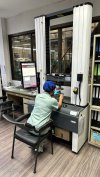TOOLING

PROCESS
Powder metallurgy is a manufacturing process where fine metal parts are compressed under high pressure and later sintered to bond the pressed materials together. The process requires one essential component and it is called a die & mold set or tooling, which is responsible for giving metal parts the required shape.
While compacting and sintering machines are all important for the powder metallurgy manufacturing method, the process is moot without the help of dies that give powders the required shape. The tooling is essential, since it can make or break your whole manufacturing process.
A tooling done right will be a benefit to the whole manufacturing process and at Thai Carbon & Graphite we do our own production and toolings.
FINAL SHAPING.
The reason for manufacturing using the powder metallurgy process is that the process is fast, cheap, and the parts are sturdy. However, the whole process comes to a grinding halt if extra machining is required to give sintered parts the design needed.
For manufacturing tooling for the powder metallurgy process, there needs to be a surety that no extra work is needed beyond creating the design of the die. A little bit of secondary operation might be done, but tooling with less complication and more simplicity in design should be selected to maximize the output.




TOOLING PROTECTION
Powder metallurgy is a long and repetitive process which means more stress on the tooling, which has to withstand a sustained level of pressure. So, protection of tooling plays a vital role in the manufacturing process.
A combination of coating, heating, and material selection helps protect the tooling or die over extended and grueling use. So, you need to be careful selecting different combinations so that the tooling can last a longer period of time.
WALL THICKNESS
For manufacturing a good die, wall thickness plays a massive role in predicting the success of the tooling. While too thick of a wall is not the right way to go, but too-thin tooling also does not help you in the manufacturing process.
When tooling with thin walls is used, that means the part manufactured will also need to be thin. Thin wear parts mean the possibility of breakage over a short period of time, which is also true for the tooling itself.




BE AWARE OF SHARP EDGES
It is advisable to make designs where the edges are more at an angle than at a perfect radius. Sharp edges can cause difficulties during ejection step and are therefore likely to bring damage to the part produced.
When the tooling is done at a slight angle, the design may be somewhat modified, but the extraction and integrity of the die are protected. When manufacturing tooling for powder metallurgy, a design with slight angles must be utilized for optimal production results.
THE LONG VIEW
Powder metallurgy is a continuous and repetitive process, so when manufacturing tooling for this production method, you need to take the long view. A repetitive process means constant pressure for a long period of time, so the tooling must be sturdy.
In tooling manufacturing, the force used to compress powder should be considered. The force and its effect on the material of the tool dictate the success of the production. Edging and tooling designs also play an active role in taking the long view.
So, the goal is not to be short-sighted when manufacturing tooling for powder metallurgy. It is a long-lasting process where everything should be considered for the purposes of manufacturing a good die.


MIXING



COMPACTING



SINTERING



SIZING



MACHINING


STEAMING


OIL IMPREGNATION


INSPECTION



PACKAGING AND DELIVERY



- HOME HOME
- ABOUT US ABOUT US
- PRODUCT & SERVICES PRODUCT & SERVICES
- CONTACT US CONTACT US